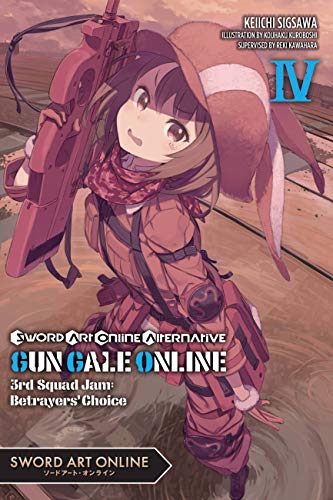By Keiichi Sigsawa and Kouhaku Kuroboshi, based on the series created by Reki Kawahara. Released in Japan by ASCII Mediaworks. Released in North America by Yen On. Translated by Stephen Paul.
You know the drill by now. This is Keiichi Sigsawa’s version of Gun Gale Online, meaning for the most part depth of characterization and plot is left at the door. Last time we at least had the real world threat of Pitohui threatening to kill herself, this time we don’t even have that, and our two teams of two join up to form a terrifying team of four, because there’s another Squad Jam, and the same people are going to be around for it. Llenn is there to see if she can finally have her battle against her gymnastics team friends; Pitohui is there because she wants to fight Llenn but will settle for this instead; M is there because Pitohui is there. and Fukaziroh is the comedy relief. This time around there’s a new rule added, but we only get to see that at the very end of the volume, so for the most part we’re here to see action scenes of LPFM (their team name) kill a lot of people. And they do.
We don’t see much of the quartet’s real world selves except at the start, where we find Karen has been avoiding GGO because a) school is happening; b) she did what she wanted to do with Pitohui and doesn’t have a concrete goal; and c) she’s still weirded out by Elza kissing her. But nothing is going to stop Elsa doing this again, even if she’d rather be fighting Llenn. The rest of the book is the Squad Jam itself, taking place on an island that’s rapidly sinking into the sea, meaning the squads have to keep moving to the center or they will die. Assuming they aren’t shot or blown up by their competitors. M, the leader this time around, holes the group up in a disused railyard, and while Llenn serves as bait (she’s fast, she won’t get killed.. probably) sets up a trap for everyone who’s going after them. And there are a lot of folks going after them, as they’re the favorites.
Of course, there are a few others we do get some development for, notably Shirley, the hunting girl from the last book who almost (but not quite) killed Pitohui. The frustration at her being unable to do this has led to her honing her skills in GGO to a terrifying degree, making her own explosive bullets and becoming a feared sniper. And there’s also Clarence, still female despite the name and the bishonen appearance, who also pulls a 180 from the previous Squad Jam where she was nice enough to give Llenn her ammo as she’s dying. Here Clarence is… well, let’s just say not as nice, but she’s certainly having fun. The battle between Clarence and Shirley may be the highlight of the volume, and I also ship them a bit now.
But of course this is Part 1 of 2, and the 2nd book promises to be even better thanks to the rule implemented at the end, which gives Pitohui her fondest desire. We’ll see how it shakes out next time. Expect lots of gunfight scenes.




